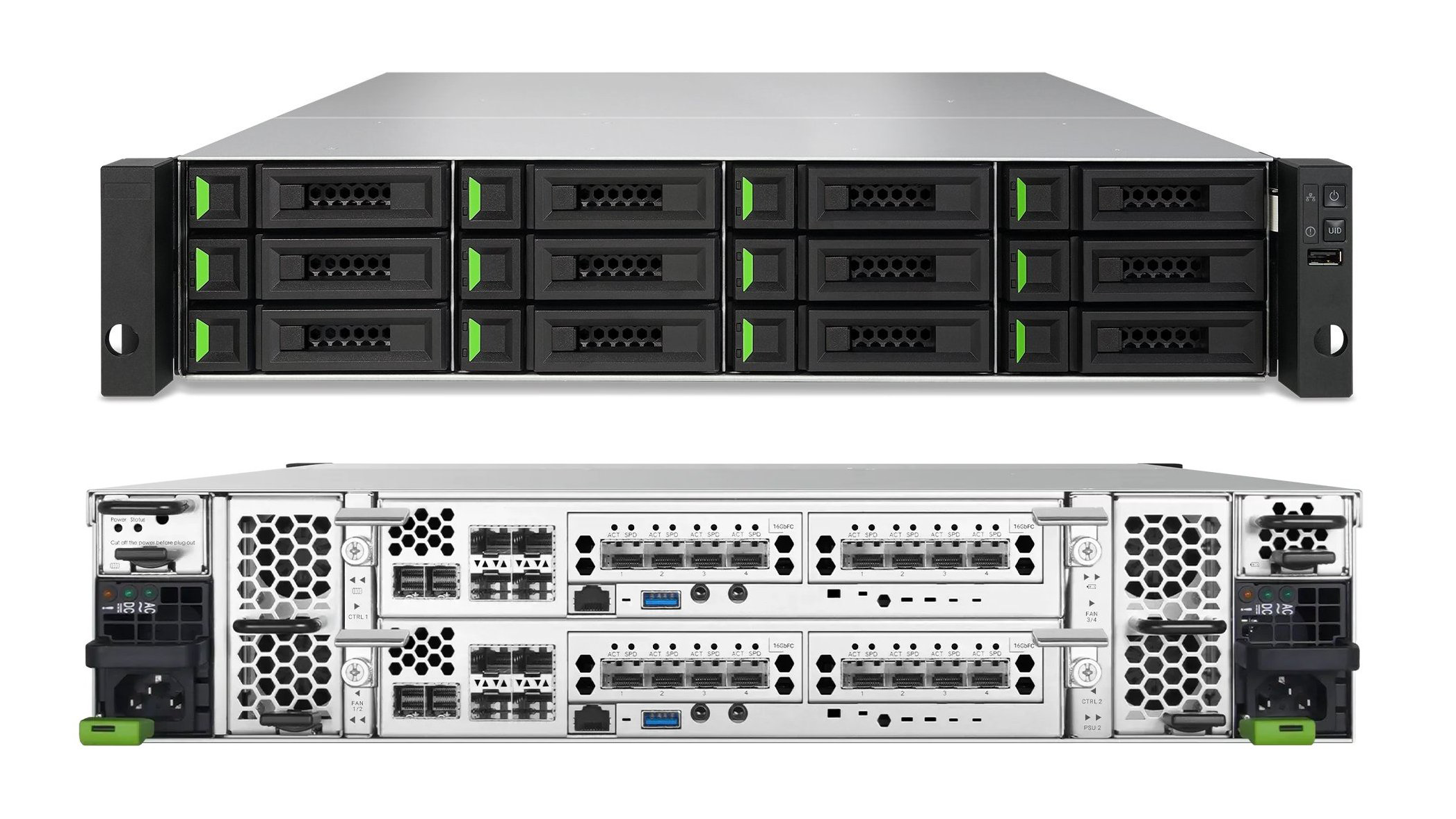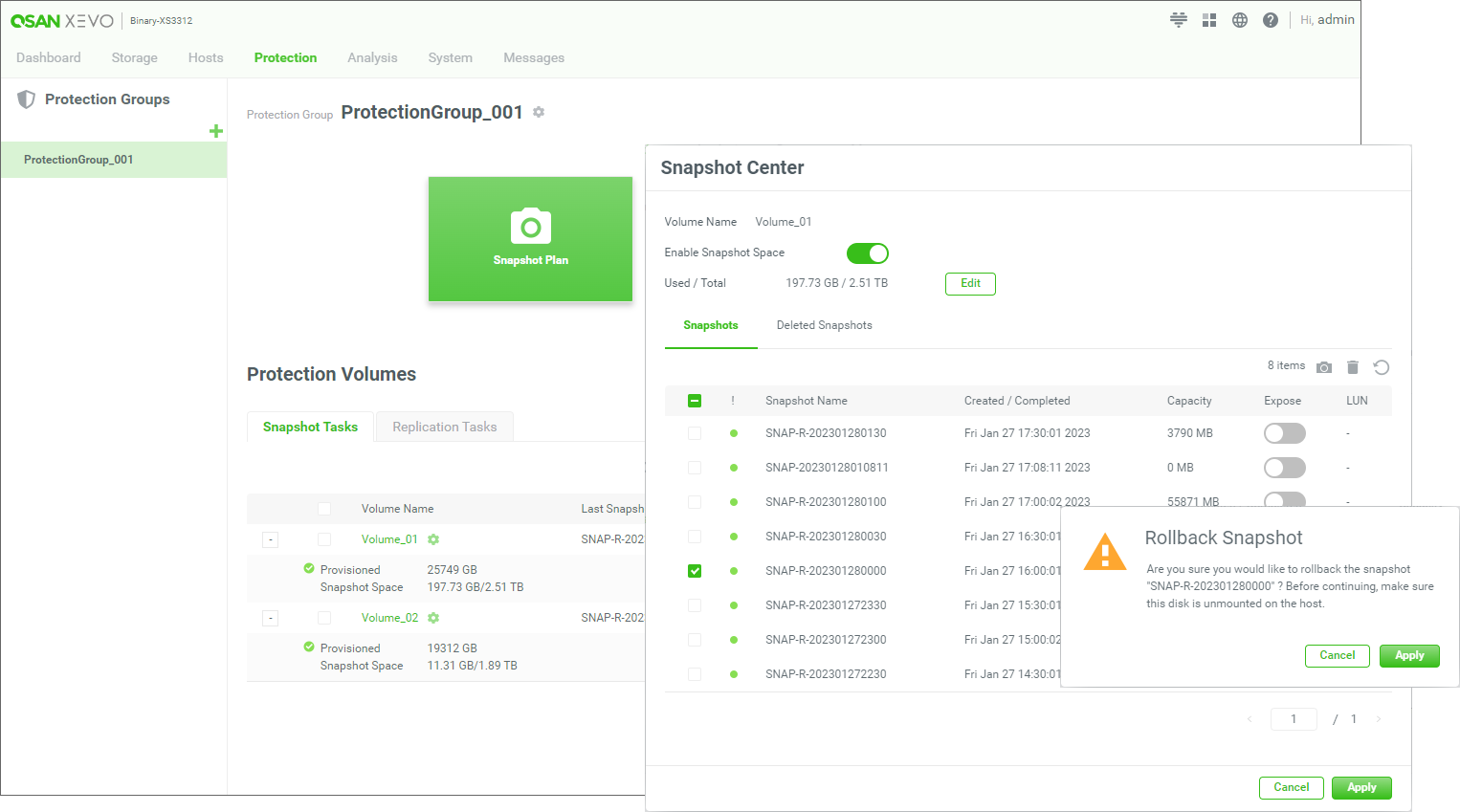Qsan XCubeSAN XS3312D review: Top SAN speed, super value
A high-performing and versatile hybrid SAN array at a price that's right for SMBs


-
+
Excellent value
-
+
Dual active/active controllers
-
+
Combined FC and IP SAN support
-
+
Massive expansion potential
-
-
No CPU stats in web console

Qsan has garnered quite a reputation in the SAN market by consistently offering SMBs a wide range of very affordable solutions. The XCubeSAN XS3312D takes this to the next level as this 2U hybrid flash storage system supports SAS3 HDDs and SSDs, comes with dual controllers supporting combined IP SAN and FC SAN operations and delivers it all at a price that'll have the blue chips weeping with frustration.
It has room up front for twelve storage devices and its end-to-end hardware redundancy offers five 9s reliability. The chassis comes with dual 850W hot-plug PSUs and twin hot-plug fan modules while the two controllers run in active-active mode and provide totally transparent failover.
Storage expansion is a key feature as each controller provides dual SAS3 ports. You can connect any of Qsan's XCubeDAS rack shelves over fault-tolerant links and with support for up to 492 drives, raw capacity can be pushed to an impressive 10.6PB using the current crop of 22TB drives.
Qsan XCubeSAN XS3312D review: Controller hardware
Each controller comes with 8GB of DDR4 ECC cache memory and their four DIMM slots allow this to be field upgraded to a generous 256GB. They are powered by embedded quad-core Intel Xeon CPUs and a quick visit to their CLI over a serial port connection reveals these to be 2GHz Xeon D-1712TR models.
Cache protection is optional and comprises separate M.2 flash and supercapacitor power modules which slot into dedicated bays on each side of the controllers. The cooling modules each incorporate two dual-rotor fans and look after the entire chassis and controllers.
Port permutations are very impressive as along with a Gigabit management port, each controller comes with four embedded 10GbE SFP+ iSCSI ports. The two expansion slots in each controller present heaps of data port opportunities with Qsan offering dual RJ-45 10GbE iSCSI, quad 10GbE SFP+ iSCSI, dual or quad 16Gbps Fibre Channel (FC), dual 32Gbps FC or dual 25GbE iSCSI and you can mix and match modules as required.
Qsan supplied our review system with quad-port 10GbE SFP+ and 16Gbps FC expansion modules in each controller and filled the bays with 7.68TB Seagate Nytro 3350 SAS3 SSDs. You can use low-cost SATA drives but these are only supported in the single controller XS3312S version.
Qsan XCubeSAN XS3312D review: Deployment
Deployment is swift as Qsan's XFinder app discovered the array on the lab network and provided direct access to its XEVO web interface. We found it very easy to use with the console's home page providing a status view comprising an overview of SSDs, pools, volumes and hosts, a pie chart showing storage and snapshot usage plus three real-time graphs for overall latency, IOPS and throughput.
From the console's Storage tab, we created two RAID5 pools each using an equal number of SSDs and allowed the wizard to add a volume in each one. You have a huge choice of RAID arrays as along with all the usual suspects, the XS3312D supports enhanced EE types which provide faster rebuild times by allowing more spare drives to be added to a pool.

We wanted to test performance over multiple MPIO links so plumped for 16Gbps FC as it's quicker to set these up than with iSCSI. For our host systems, we used Dell PowerEdge Xeon Scalable and HPE ProLiant AMD EPYC Windows Server 2022 systems each fitted with ATTO Celerity quad-port 16Gbps FC HBAs.
Host mapping is simple as all FC connections were automatically discovered so we could swiftly assign dedicated volumes to both test servers over quad FC MPIO links. A feature of the XS3312D that's well worth highlighting is its controllers function in synchronous mode and not the more-common ALUA (asymmetric logical unit access), so hosts connected across both controllers have all redundant links active and optimised.
Qsan XCubeSAN XS3312D review: FC performance
To get a baseline, we ran Iometer on one server first which reported sequential read and write rates of 48.7Gbits/sec and 47.7Gbits/sec and random rates of 48.3Gbits/sec and 23.2Gbits/sec. Swapping to Iometer 4KB blocks returned random read and write I/O throughputs of 249,300 and 80,200 IOPS
With both servers in the mix, we recorded impressive cumulative sequential read and write rates of 96.8Gbits/sec and 93.5Gbits/sec. Our read number equates to 12.1GB/sec which isn't far off Qsan's quoted maximum speed of 12.8GB/sec.
Random read and write performance for both servers added up to 95.6Gbits/sec and 45.8Gbits/sec while total throughput for random reads and writes settled at 363,800 and 132,700 IOPS. We wished we could see CPU utilisation during these tests but this is one metric the XEVO interface doesn't provide.
Qsan XCubeSAN XS3312D review: Data protection features
Protection groups simplify snapshot management as you add multiple volumes from different storage pools to one group and protect them all with a single schedule. Group snapshots can be set to run daily, weekly on specific days or monthly or as often as every 5 minutes and they can be run on demand as well.
Data recovery is undemanding as the gear wheel next to a volume loads the XEVO Snapshot Center which lists all available snapshots. Choose one and you can roll the volume back to a specific point in time or expose the snapshot as a new LUN for manual data recovery.

The price also includes services for replication of volumes to another local storage pool or remotely to an external array and these can be combined with snapshots in the same protection group. Network bandwidth controls for remote replication offer a choice of eight traffic shaping groups which are used to enforce bandwidth restrictions during peak and off-peak periods.
Qsan XCubeSAN XS3312D review: Verdict
With an MSRP of around £6,400 for a diskless unit, the XCubeSAN XS3312D offers SMBs a top value storage solution that can easily grow with demand. Along with excellent FC performance, its dual active/active controllers deliver transparent failover and Qsan's XEVO OS offers a great set of easily managed storage provisioning and data protection features.
Qsan XCubeSAN XS3312D specifications
| Chassis | 2U rack |
| Storage | 12 x LFF/SFF SAS3 hot-swap bays |
| Power | 2 x 850W Platinum Plus hot-plug PSUs |
| Cooling | 2 x hot-plug dual-rotor fan modules |
| Controllers | Dual active/active controllers each with the following: |
| CPU | 2GHz quad-core Intel Xeon D-1712TR |
| Memory | 8GB DDR4 ECC cache (max 256GB) |
| Cache protection | Optional cache to Flash module |
| Array support | RAID 0, 1, 10, 3, 5, 6, 10, 30, 50, 60, N-way, 5EE, 6EE, 50EE, 60EE |
| Ports | Gigabit management, 4 x 10GbE SFP+ iSCSI data ports, 2 x SAS3 expansion ports |
| Expansion bays | 2 module slots |
| Management | Web browser |
| Warranty | 3-year limited, 1yr for Cache to Flash module |
Get the ITPro daily newsletter
Sign up today and you will receive a free copy of our Future Focus 2025 report - the leading guidance on AI, cybersecurity and other IT challenges as per 700+ senior executives
Dave is an IT consultant and freelance journalist specialising in hands-on reviews of computer networking products covering all market sectors from small businesses to enterprises. Founder of Binary Testing Ltd – the UK’s premier independent network testing laboratory - Dave has over 45 years of experience in the IT industry.
Dave has produced many thousands of in-depth business networking product reviews from his lab which have been reproduced globally. Writing for ITPro and its sister title, PC Pro, he covers all areas of business IT infrastructure, including servers, storage, network security, data protection, cloud, infrastructure and services.
-
 ‘Phishing kits are a force multiplier': Cheap cyber crime kits can be bought on the dark web for less than $25 – and experts warn it’s lowering the barrier of entry for amateur hackers
‘Phishing kits are a force multiplier': Cheap cyber crime kits can be bought on the dark web for less than $25 – and experts warn it’s lowering the barrier of entry for amateur hackersNews Research from NordVPN shows phishing kits are now widely available on the dark web and via messaging apps like Telegram, and are often selling for less than $25.
By Emma Woollacott Published
-
 Redis unveils new tools for developers working on AI applications
Redis unveils new tools for developers working on AI applicationsNews Redis has announced new tools aimed at making it easier for AI developers to build applications and optimize large language model (LLM) outputs.
By Ross Kelly Published
-
 Google layoffs continue with "hundreds" cut from Chrome, Android, and Pixel teams
Google layoffs continue with "hundreds" cut from Chrome, Android, and Pixel teamsNews The tech giant's efficiency drive enters a third year with devices teams the latest target
By Bobby Hellard Published